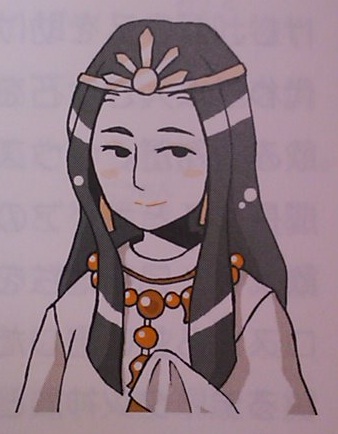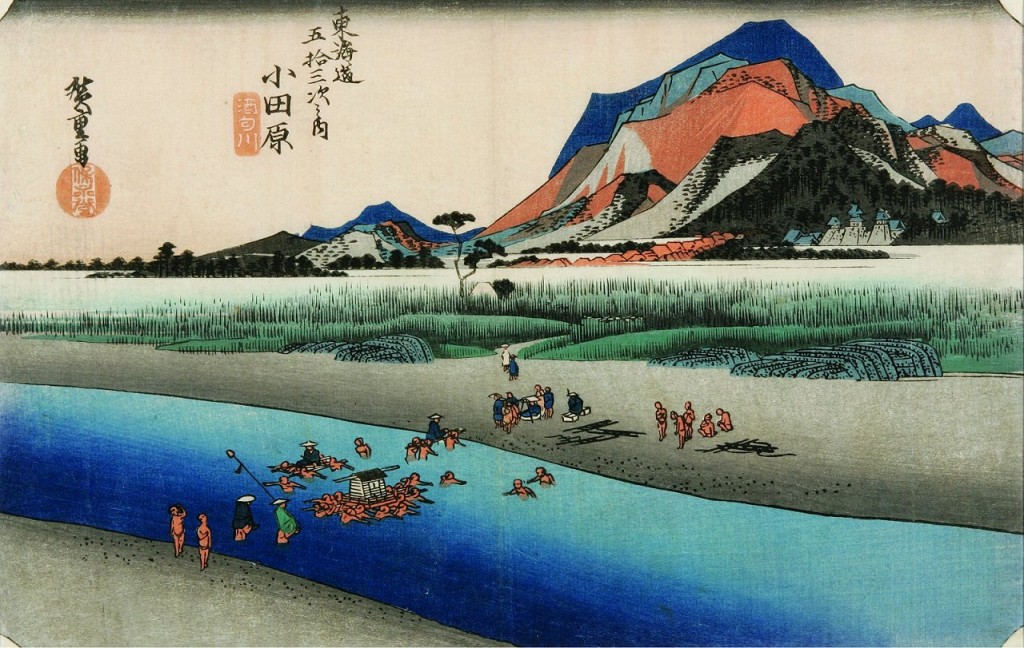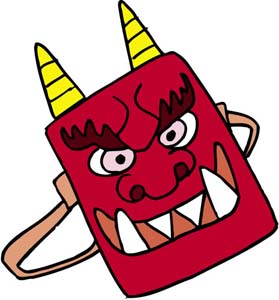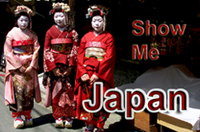
アマテラス様
All facts from 「日本神話とギリシア神話」 Japanese and Greek Myth by 大脇由紀子 Ōwaki Yukiko (明治書院、2010). All opinions are mine.
- Fact: Japanese did not have a word for “myth” until Basil Hall Chamberlain invented one in 1887. What they instead had was an official history that ranged from cosmic to national in nature. Not even those skeptical of that history borrowed the word “myth” from English; it took a foreigner to do that.
- Opinion: It is thus only natural to wonder, what is the meaning-function of the word “myth”, and why was it not invented in Japanese? In this book, one of the figures mentioned is Empress Consort Iwanohime, simply because she is mentioned in the official histories Nihonshoki and Kojiki. Her life has no supernatural aspect to it.
- Opinion: Japanese Wikipedia suggests the word 神語(り) kangatari was used to refer to myths in the Middle Ages, but a check of academic literature shows that it actually referred to recited poetry, five examples of which can be found here. Also, the true reading appears to be kamugatari. In ancient Greece, indeed, “mythos” was a term used for any recitation. Perhaps our use of the word “myth” is at its very heart a misunderstanding.
- Fact: The author makes a fascinating comparison between Iwanohime and Hera: both individuals were said to have intense jealousy directed not only at their closest relations but at other individuals who associated with them.
- Opinion: Certainly Iwanohime’s jealousy could have served as a cultural standard in the same way that Hera’s jealousy did in Greece. It is fascinating to imagine in this way the world that the writers of Nihonshoki and Kojiki may have lived in. But does that mean Iwanohime was a “mythical” figure, or a god, in the same way that Amaterasu’s story can be pigeonholed as myth? Perhaps it is better to view these figures in the same way the Japanese did: as characters in the official history.
- Fact: The exiled hero Yamatotakeru is shown as wandering all over Japan, much like Odysseus, except that the Odyssey doesn’t fall into the category of “myth” in this book for some reason…
- Opinion: In this book kami is defined as “a word encompassing beings with incorporeal power beyond human knowledge.” Aliens??
- Opinion: I bought this book to learn the full extent of parallels between Japanese and Greek mythology, but it seems like most elements can be dismissed as coincidence. The most confounding parallel is the one any student of mythology should know: the Greek story of the rape of Persephone is extremely similar to the Japanese story of Izanami’s death.
- Fact: When discussing this, the book quotes from Spirited Away (remember Chihiro starting to disappear and eating the food?). Mayhaps Ghibli movies are a better re-presentation of Japanese mythology than anything I could hope to write myself.
- Fact: But the book references Naruto as well…
Posted: April 6th, 2011 | Japan, Secular-Religious
The short version: If you support one of the corporations on this list you are giving aid to a group of professional bullies who pretend to care about whales but are actually solely interested in harassing villagers.
Read the rest of this entry »
Posted: April 5th, 2011 | Japan, Res pueriles

I just watched yet another program on Ninomiya Sontoku, aka Kinjiro, that considers him as a statue. Schools throughout Japan have Kinjiro statues, as do some other institutions and many private individuals. These statues were handed down from previous generations and most people don’t quite know who Kinjiro was besides someone who read a lot of books. I know some variety shows do discuss him as an actual person, but they seem to mostly rattle off stats and figures and argue over whether he was a bureaucrat or an economist, or some asinine thing. I’ve never heard anyone tell the following story:
When Kinjiro was born, the family were really in hard straits. To add to their distress, when Kinjiro was five years old, the Sa[kawa] River overflowed its banks and washed away his father’s land, leaving them in abject poverty.
[…]
When Kinjiro was about twelve years of age, he went to work for a year with a farmer in the neighborhood. At the end of the year, before starting for home, he received, in addition to his board and lodging, a Japanese kimono and about two yen. His mother expected him early and was waiting for him, but when at night he had not returned, she became quite anxious. Shortly after dark he came rushing in, all out of breath, and full of excitement. When his mother reproved him for being late, he told her that in the morning he had received from his master a kimono and two yen, and had immediately set out for home. On the way he had met a man with a lot of little pine trees for sale. The poor man was very disheartened, because he had not succeeded in selling a single tree, and told Kinjiro that unless he could find a buyer he would be very much distressed. Kinjiro was sorry for the man, and an idea struck him whereby he could not only help the man, but could at the same time do the whole community a good service. As we already know, the Sa[kawa] River sometimes overflowed its banks. Kinjiro thought if a couple of rows of pine trees were planted along the banks of the river, and once took root, it would remedy this difficulty. So he bought all the trees and spent the remainder of the day planting them. He felt sure his work would have its reward. To-day those trees are large, and not only support the river bank, but add much to the beauty of the scenery. They stand as a living monument of little Kinjiro’s thoughtfulness.
“Just before the dawn: the life and work of Ninomiya Sontoku” by Robert Cornell Armstrong (1912)
Let’s put aside the fact that Kinjiro gave the fruits of a year’s labor to save a local farmer. What is clear is that the problem Kinjiro solved is one that was also faced by the people of Japan in the 1960s. Rivers in Japan frequently overflow and damage riverside structures. Or, at least, they used to. Nearly all the rivers in Japan have been filled in completely with concrete. Nobody ever thought to plant multiple rows of trees on the riverbanks. The Sakawa River itself has been dammed, and Kinjiro’s surviving trees were almost chopped down by thoughtless bureaucrats; the townspeople saved them.
Kinjiro was beloved by the people of his area because of his wisdom and his big heart. The people of Odawara City where he was born still remember him fondly today, referring to him as “Sontoku-sama”, and honoring the trees he planted there. A few websites therefore relate the story of the planting, but nobody seems to have made this connection with the state of Japan’s rivers today. Would that we had more like Kinjiro, and fewer building statues of him.
Posted: February 11th, 2011 | Kokoro
 [If you saw a previous post — this came from my diary. Upon thinking about it further, I’ve decided to return it there.]
[If you saw a previous post — this came from my diary. Upon thinking about it further, I’ve decided to return it there.]
Today I taught second graders. The lesson was related to Setsubun, the old holiday where you throw beans at oni/ogres to keep them out of your house, and I instructed the kids on drawing oni using the English words “eyes, nose, mouth” (and somehow “horns” got into there too). The kids caught on quickly. One class demanded my signature, while the other had a veritable league of little artists drawing their oni in Cubist or Post-Impressionist style. Then, all of a sudden the teacher asked them to write their “kokoro no oni”, or “ogre of your heart”, underneath the picture.
It took me some mental bridging to figure out that an “ogre of your heart” means something that is preventing you from being a good kid, but the kids seemed to get it with no problem. Is this an ordinary Japanese expression? Not only did they understand what a “kokoro no oni” was, most of them quickly figured out which “oni” they thought plagued their hearts the most and wrote it down on the paper in a manner of seconds. Some examples of what they wrote:
- しゅくだいさぼるおにをたいじぞ! Defeat the ogre of skipping homework!
- べんきょうしないおにをたいじぞ! Defeat the ogre of not studying!
- わすれんぼうおにをたいじぞ! Defeat the ogre of forgetfulness!
- きゅうしょくのこるおにをたいじぞ! Defeat the ogre of leaving food on your plate at lunch!
- いじわるおにをたいじぞ! Defeat the ogre of being rude!
- はずかしがるおにをたいじぞ! Defeat the ogre of being shy!
- かん字きらいおにをたいじぞ! Defeat the ogre of disliking kanji!
Wow! They could all grow up to be school counselors!
I guess I shouldn’t be surprised that Japanese kids can identify their own faults. School rules such as studying well and eating your food at lunch are stressed throughout the year, and character flaws like rudeness and shyness are discussed on most popular children’s shows. Still, I can’t imagine American elementary schoolers being able to complete an assignment like this so quickly. Little kids truly have a lot of thinking power that can be molded into many different things.
Posted: January 28th, 2011 | JET
Continuing where part 1 left off. Now you can learn about what I did in Tokyo.
Read the rest of this entry »
Posted: January 2nd, 2011 | Travel
The vacation you’re about to see requires a fair bit of explanation, so I’m releasing my photos as a blog post. Please note that there are more pictures in the Picasa album.
Read the rest of this entry »
Posted: January 2nd, 2011 | Travel

Karatsu Kunchi is a harvest festival that’s held every November. The entire town of Karatsu counts down to this day every year. Work stops everywhere and everyone parties. They carry huge floats around. The pictures speak for themselves really.
HUGE images ahead! Read the rest of this entry »
Posted: November 19th, 2010 | Japan
As we students of the Takenouchi Documents already know, when Moses rode a UFO to Japan he presented the world with a second set of Ten Commandments. Actually, it was simply the same stone tablets, but he had forgotten to show the Israelites what was written on the back side. Anyway, here they are in English for the first time:
Honoring the law of Romulus, 60th generation descendant of Adam and Eve
Omoyakami Taruwake Toyosuki Emperor Hitsuki 200 Years — 10 Commandments of Moses
1. Thou shalt worship the gods of Heavenly Omoya Japan
2. Thou shalt worship the Omuya Hitsuki Emperor
3. Thou shalt not disobey the Sun Kami, for if thee do thou willst be smited
4. Thou shalt not disobey the law of the emperor of the Heavenly Omoya
5. Thou shalt not disobey the emperor of the Omoya
6. Thou shalt protect the law of the five races of Ajiti
7. Thou shalt not disobey the law of the Omoya of the Ajitikunists, the decided law of Ajitikuni
8. Thou shalt rescue the red and correct the black of heart
9. Thou shalt inform thyself of the stories of other kami
10. Thou shalt worship the spirit kami — Twice, Āmen!
The law of all nations. 10 Commandments of Moses, Mount Sinai
You can visit Moses’ grave in Ishikawa-ken.
Posted: October 26th, 2010 | Japan
Have you ever had a Japanese person come up to you on the street and tell you about the oldest XYZ in Japan which you can find in this particular area? This happened to me for the second time today. My friends and I were looking vaguely out at the harbor in Dejima, and a complete stranger–naturally, an ojisan–approached us and talked about the oldest Protestant seminary in alllll of Japan which used to be on Dejima but was moved somewhere else. The first time was on my study abroad, when a stranger, also an ojisan, sat next to me on the train holding a binder full of laminated newspaper clippings, ascertained that I didn’t know enough Japanese to comprehend his vital message, and went to tell my program director about how this particular area of Kyoto was in fact the oldest human settlement in Japan, but had been covered up by an official conspiracy.
I reflected on these unusual events after hearing my professor friend say this evening, “It’s not that Japanese people don’t have an opinion about history, but we don’t speak about our opinions.” This is both true and false in extremely important ways. As I understand it so far, not quite knowing enough Japanese to read Beat Takeshi’s History of 20th Century Japan, there are five ways in which Japanese people are interested in history. The first is the usual, bookish memorization of names and dates as taught in middle schools, and keeping any underlying narrative to oneself. The rekijo seem to be mostly of this first category. Indeed, this normal mode of history is purely about facts and has nothing to do with opinions other than those of the “rules-sucks” type.
The second is the myopic obsession with blaming people from history for the problems of today, which has caused endless Japan-bashing. The third is the equally myopic defense of every Japanese person in all of history against the attacks of the critics, which is just as lame. These two types of interpreting history are based on very deeply held opinions, but the one thing people hate to do in these discussions is admit they have an opinion; thus they will present their opinion as an unbiased exposition of the facts, even when this strains credulity, which only adds rancor to the discussion.
The fourth type, just to acknowledge its existence, is the actual opinionated narrative that directly contradicts my professor friend’s statement. I am guessing Beat Takeshi’s book is one such example, based on the Amazon reviews. It is nice to know what Japanese people think about their own history, and even nicer to read it in a book instead of painstakingly exacting it during a conversation. These books are still rare, though.
But the fifth type most interests me, because it is absent from Western historiography. There are a large number of middle-aged men in Japan (and perhaps a rekijo or two) who have scientifically and accurately determined that some whatsit in their hometown is the OLDEST WHATSIT IN ALL JAPAN, and must get the word out about this old whatsit to the entire world, especially notifying any foreigners that happen to come pass through the area. Of course, every country in some way has a mania for the ancient. The only country that has not traditionally obsessed over its own age is India, and even that is now changing. But in Japan this manifests in a unique way. Perhaps these ojisans are continuing that great kokugaku quest to find the purity of ancient times. (Speaking of which, doesn’t that make this historiography predate the other four kinds of historiographies? You know, I think it does!) Perhaps they just have too much free time on their hands, and spend every Sunday patrolling for possible recruits to their cult of the old thingamabob. Who knows? It is something to explore if you ever encounter it in Japan. Just learn Japanese first, because they often don’t know English.
Posted: September 26th, 2010 | Kokoro
Maybe not a lot of people know that Twitter in Japan has its own vocabulary. Talking with your buddies on Twitter is kind of like meeting them on the street.
Read the rest of this entry »
Posted: June 25th, 2010 | Japan




